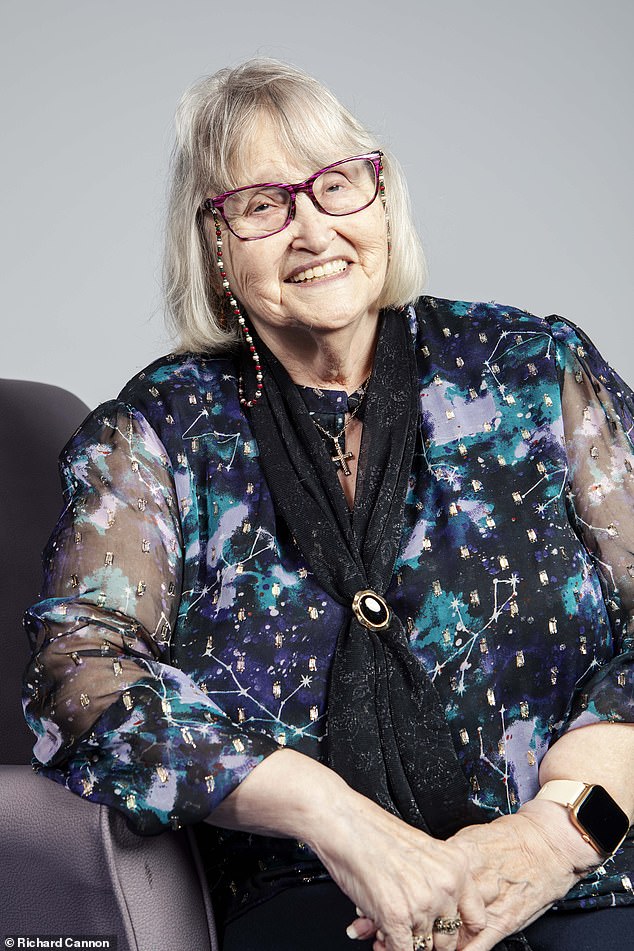No one wants to be sick – or stuck on medication for life. But what if you could take control of your health and reverse chronic conditions?
From dementia to crumbling bones, we spoke to four patients who proved it is possible to stop their health declining and defy their doctors’ prognoses, with simple lifestyle and diet changes, helping them to avoid chronic disease and a lifetime of prescriptions.
When there’s still time to halt dementia in its tracks

Dawn Warner had a stroke seven years ago and a subsequent scan showed signs of dementia
Dawn Warner, 75, is a retired carer who lives in Herne Bay, Kent, with her husband Ivan, 81. She says:
I had a stroke seven years ago and was blue-lighted to hospital, where I was given a brain scan.
Thankfully there was minimal damage from the stroke, but the scan did show that I had early signs of dementia. It was a combination of Alzheimer’s and vascular dementia, where narrowing of the blood vessels restricts oxygen flow to the brain.
I was prescribed memantine, a drug that slows brain decline and protects brain cells, but I was told I needed to make some lifestyle changes because if caught early, this mixed dementia could be reversed.
I was asked to stay as active as possible and to exercise my brain.
My husband Ivan, 81, made sure I went for a daily walk and I started going to a nearby Age UK centre, where I socialised with lots of others and they offered activities that challenge the brain, such as card games, word games and bingo.
Now my consultant says because I caught it early and am doing so much to combat it, I could have another 15 years before I suffer a really bad decline.
Expert comment: ‘Currently there are no cures for dementia, but when it’s picked up in its early stages, there are modifiable risk factors that could potentially improve brain health and reverse it,’ says Dr Tomas Welsh, a consultant physician in geriatric medicine at Royal United Hospitals Bath.
‘These include addressing factors that are known to harm the brain directly, such as smoking, excess alcohol consumption and high body weight.
‘Controlling blood pressure and cholesterol in mid-life also reduces the risks in later life, as can correcting any problems with hearing and vision promptly.
‘And exercise is vital. We know that people who participate in sport and exercise are less likely to develop dementia [one reason being it helps increase blood flow to the brain].
‘As for “brain training”, these are activities that encourage the brain to change and adapt – building new connections between brain cells. Lifelong learning, mental stimulation and social interaction all help build greater reserves into the brain. This means that if some pathways are damaged by a disease such as Alzheimer’s, others are present which the brain can fall back on.
‘Social interaction also helps to strengthen existing pathways. A significant proportion of the risk of developing dementia is potentially reversible.’
British Geriatric Society: www.bgs.org.uk
On the cusp of high blood pressure
Joyce Agyare-Twum, 53, works for the British Heart Foundation, lives in Surbiton, south-west London, and has two grown-up children. She says:
When I was 38, I had a blood pressure check at a routine clinic appointment for contraception. The nurse said it was high – 140/90 – and advised me to see my GP.
But I ignored it and two months later, I had another blood-pressure check before I was given anaesthetic for gum surgery and the doctor said it was too high for the procedure to go ahead. I was shocked and felt silly for ignoring it.
Days later I went to see the GP, who diagnosed pre-hypertension – where it’s on the verge of being dangerously high – and gave me a low dose of the blood-pressure drug ramipril and told me to cut down on salt and exercise more to avoid full-blown hypertension.
I started walking daily, eating more fruit and within a week on the medication, my blood pressure dropped. It’s now a healthy 96/68 – a normal range is between 90/60 mmHg and 120/80 mmHg.
I still take a very low dose of 2.5mg for peace of mind, though one GP has said my readings are now low enough to stop completely.
Expert comment: ‘High-normal blood pressure, sometimes called ‘pre-hypertension’, is when you don’t have an ideal blood pressure but you also don’t have high blood pressure,’ says Julie Ward, senior cardiac nurse at the British Heart Foundation.
‘It’s usually considered to be between 120/80 mmHg and 140/90 mmHg. It can be a sign that your blood pressure is rising and you may develop hypertension in the future.
‘Taking steps to lower your blood pressure at this level is recommended so you don’t develop hypertension. High blood pressure is a serious condition. Your arteries are normally stretchy, so they can cope with your blood pressure going up and down. But with high blood pressure, your arteries lose their stretchiness, becoming stiff or narrow.
‘This narrowing makes it easier for fatty material (atheroma) to build up. This narrowing and damage to the arteries lining your heart or brain could trigger a life-threatening heart attack or stroke.
‘If left untreated, high blood pressure can also lead to complications such as kidney failure, heart failure, sight problems and vascular dementia.
‘Up to five million people in the UK are thought to have undiagnosed high blood pressure and many more pre-hypertension.’
British Heart Foundation: bhf.org.uk
Signs you’re at risk of diabetes
Shanine Fasasi was told she was pre-diabetic and was forced to take drastic action as a result
Shanine Fasasi, 38, a community worker, lives in Nottingham, is married and a mother of five. She says:
Two years ago, I was busy finishing university as a mature student and starting a new job as a community worker. I was always on the go, eating junk food and never had time for proper meals.
I started feeling very unwell – aching, sick and just tired all the time – and went to my GP, who did a fasting blood glucose test to measure my blood-sugar levels.
When I returned for the results a day later, I was told I was pre-diabetic with a HbA1C score (a measure of glucose in the blood) of 44 (anything over 47 is diabetes). In short, I was heading for diabetes unless I took drastic action.
The doctor gave me a lifestyle plan and diet, telling me to exercise more and avoid junk food.
I am from the Caribbean and love plantain, rice, carb-heavy foods as well as sweet things – but I had to give all that up.
Now I walk whenever I can, do cardio and weights at the gym and cut out sugar.
I am determined not to fall into the diabetic category as I don’t want to be reliant on insulin or even risk awful things such as limb amputation – and so far I seem to have avoided it.
Expert comment: ‘Around 3.6million people in the UK have pre-diabetes and the numbers are rising,’ says Dr Jan Toledano, founder of the London Hormone Clinic.
‘Among those under 40, they rose by almost a quarter – from 173,166 to 216,440 – between 2022 and 2023.
‘Pre-diabetes is a low-grade inflammation in the body that drives most chronic diseases.
‘When we eat any sugar or carbohydrates, the pancreas releases insulin to help the body burn it up and keep blood sugar within a narrow, normal range. If the body does not listen to the insulin message properly, this sugar gets deposited as abdominal fat – causing pre-diabetes, a process that can take 20 years.
‘But it is totally reversible with a low-carb diet 70 per cent of the time. It is the day-to-day carbs that matter, not a Christmas dinner or special night out.
‘The pancreas needs a break from being constantly stimulated when we eat high-carbohydrate foods – even just lowering intake on weekdays only is often enough to rest the pancreas and metabolise the visceral fat round the middle, reversing pre-diabetes.’
Red alert for osteoporosis

Emily Griffiths was placed into early menopause, leading to hot flushes, aches and pains
Emily Griffiths, 27, runs a women’s health business and lives in Carmarthen, Wales. She says:
I’ve had endometriosis, where tissue similar to the lining of the uterus grows outside of the womb, and adenomyosis, a similar condition where the lining of the womb (the endometrium) grows into its muscular wall, since I was young.
I’ve suffered really heavy periods and terrible pain every month. I’ve been prescribed a drug to stop the heavy bleeding and pain since I was 21.
But soon after, because of the way it works – suppressing the ovaries’ production of hormones such as oestrogen and progesterone – the drug put me into early menopause. Within weeks I had hot flushes, aches, pains and night sweats.
I was terrified as I knew it meant I could no longer have children, but the thing I was most concerned about was my bones. I’d read that premature menopause increases the risk of osteoporosis, where bones become weak and brittle, making them more susceptible to fractures.
An NHS bone scan six months later showed I had osteopenia, where your bone mineral density is lower than normal and is a precursor to osteoporosis.
The consultant told me to take a high-dose vitamin D supplement and get as much natural sunlight as possible, as this increases the bone’s ability to absorb calcium. I also had to increase my calcium intake.
Since then, I’ve taken vitamin D supplements regularly and increased my calcium consumption. I am also getting a private referral to a consultant to ask about other steps I can take to protect my bones. I’ve read that if I do this I might be able to halt or even reverse my osteopenia.
Expert comment: ‘It’s hard to say how many people in the UK have osteopenia, as it does not make you feel unwell,’ says Dr Nicky Peel, a specialist in metabolic bone medicine and spokesman for the Royal Osteoporosis Society.
‘But if you detect it early you can take steps to reverse it.
‘With osteoporosis, which affects three million people in the UK, often the first sign is a fracture. You can’t feel or see when you have thinning of the bones and it doesn’t cause symptoms, and that’s why it’s important people are aware of their bone health.
‘If someone is identified as having osteopenia then lifestyle changes can at least slow its progress – including consuming more calcium-rich foods, getting out in the sunshine (for vitamin D) and taking vitamin D supplements. Avoiding smoking and excess alcohol consumption also helps, as does doing regular weight-bearing exercise.
‘It’s unrealistic to think lifestyle factors alone will prevent all bone loss – it’s part of ageing – but certainly the rate of bone loss can be modified by following this type of healthy lifestyle.’












